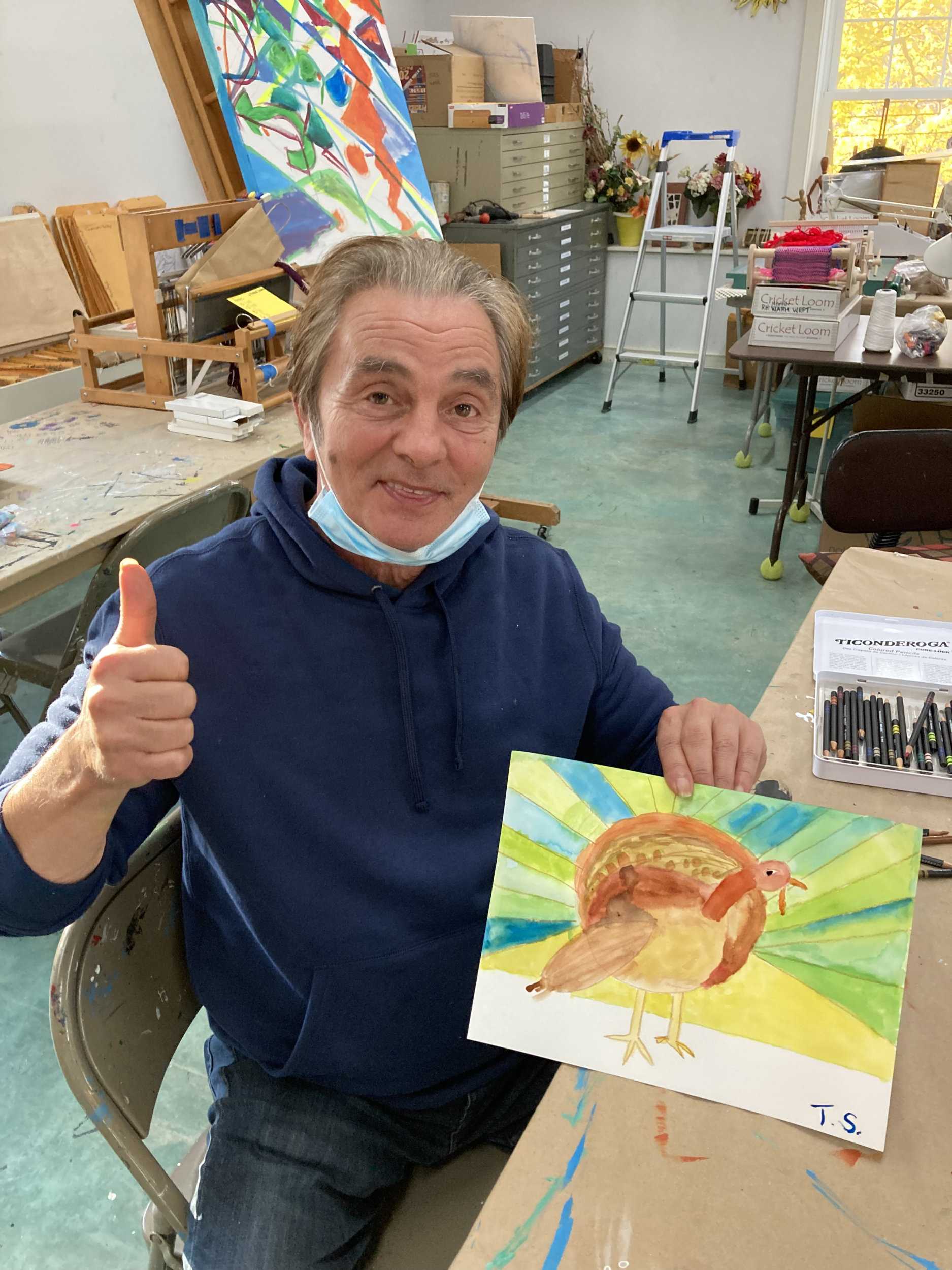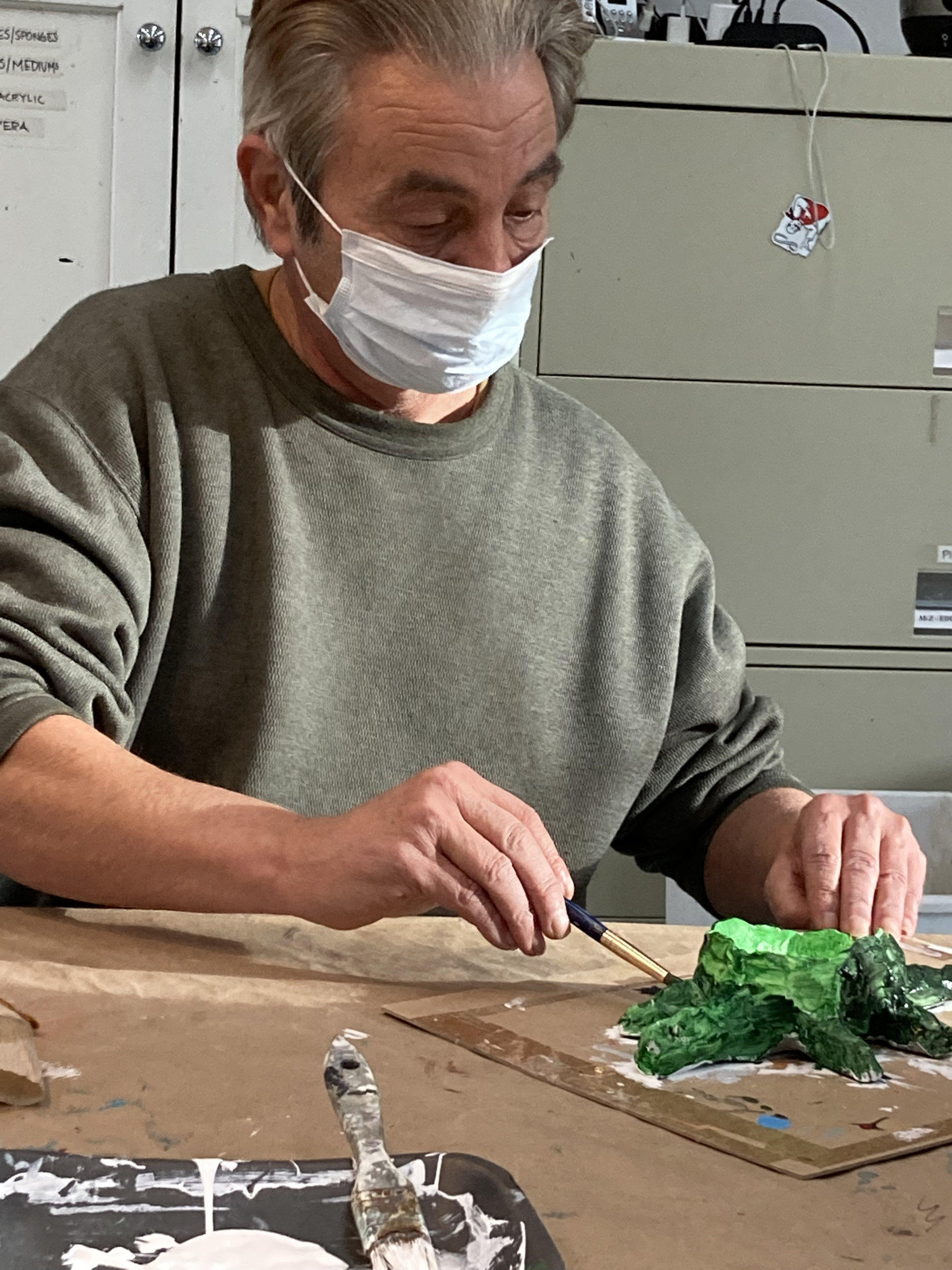
Brain Injury Awareness Month: Painting the Big Picture
March is Brain Injury Awareness Month, and this years theme is More Than My Brain Injury. At least 3.6 million people in the United States sustain a brain injury each year, and just about 8 percent of the adults we serve at Ability Beyond live with an acquired or traumatic brain injury-including Tom, and his peers in an ongoing class offered by Georgetown School of the Arts.
Ability Beyond client Tom, of Ridgefield, describes himself as an “artist who doesn’t follow the rules of society, then he breaks into warm laughter, and flashes a bright smile.
He’s only half-joking. Tom is an artist.
The 62 year old began working with oils in his early 20s, as an apprentice at the General Motors Technical Center, and first learned how to paint on automobiles. He showed an early aptitude for the craft (a slow, steady hand, he says) and, over time, he moved from the medium of cars to canvas, and fine art.
Portraits, caricatures, still life, Tom says. You name it, I do it. At the moment he’s working on a painting of his church that will adorn its walls when it’s finished.
Tom picked up the paintbrush just a few years after he sustained a traumatic brain injury at 19, in a motorcycle accident that altered the course of his life. Decades later, he continues to find himself in art, challenging himself through different mediums and exploring his creative self-expression, most recently through a class at Georgetown School of the Arts (GSA) taught by the school’s owner, Susan Jackson.
“Weaving, clay sculpture he doesn’t have any resistance to trying something new, and he really enjoys it, Susan says. “It’s always a win in that class. We all look forward to it.

Susan launched the class about four years ago, for Ability Beyond clients with brain injuries. Even during COVID-19, Susanâ’s core group of students, including familiar Ability Beyond faces such as Zach and Ron, continued to participate over Zoom, working from home with art kits that Susan packed with six weeks worth of materials: watercolors, acrylic paints, wood pieces, brushes, and more.
The mission of my school is that children can grow up comfortable with drawing as a life tool” Susan says. I’ve applied the same principles to my class with Ability Beyond, breaking techniques down and helping students recognize shapes. And I have seen an amazing amount of improvement. They’re really learning art. As the years have progressed, there are less questions and more comfort.
Acquired Brain Injury (ABI) Service Manager Kelly Stein says the art class is a vibrant example of how Ability Beyond staff and partners work to discover, build, and celebrate the potential of each person we serve. In fact, it was Kelly’s urging that gave rise to the class in the first place.
“If we can’t teach you ourselves” she says, we will find a way to help you learn in the community.
Ability Beyond has been a careforce pioneer for people with brain injuries since the 1980s, when we became the first organization in the northeast to provide them with day and residential services. In 1995, we launched the first services in New York for people with brain injuries. Our model is fully integrated and community-based, helping people set and achieve personal goals from employment to independent living, and even artistic endeavors.
“Ability Beyond has helped me by teaching me how to shop for myself, live independently, and keep my apartment clean” says client Kathy, a longtime Leir employee.

Another client, Danny, who works at a local Stop and Shop, says that after his accident he had to learn how to do everything over.
Ability Beyond helped me tremendously, especially with a job specialist, he says. They make sure everything is done properly, in a timely fashion, and the right way. Like a backup, so I don’t mess things up.
Through his services at Ability Beyond, Tom when he’s not painting, is the newest cashier at The Black Cat, a cafe at Ability Beyond headquarters in Bethel. (“You gotta come and try the coffee,” he says. “It’s the best.”)
During and beyond Brain Injury Awareness Month, Kelly said it’s important to remember that, for people with acquired or traumatic brain injuries, there is a before and after moment in life that everyone relates to differently.
In our program, she says, every single person you interact with was an atypical healthy person, working and living, some were married, some had children. Then one day their life changed. One moment. There was an automotive accident or a stroke or an aneurysm or something happened to acquire a brain injury.
After his accident, for instance, Tom said he cycled through the grief emotions: acceptance, denial, reassurance, on a daily, sometimes hourly basis, due both to the scale of the trauma and complications with short-term memory that persist to this day. Yet now, to speak with Tom for just a few minutes is to experience his refreshing, hard-won perspective and sense of humor.
Tom is quick to make an affectionate joke. And he knows how to laugh at himself.
When you ask him, “What has changed your life?” he doesn’t mention the accident. He says, love and consideration.
He takes it in stride, says Patrick Boisvert, who has been working with Tom since he first came to Ability Beyond in spring 2014. Over the years, Tom’s once an at-home caretaker for his aging parents has gone from a full house to an empty nest, after his mother passed away and his father transitioned into a nursing home; and from working part-time at Duracell to being unemployed after the company closed the site during the pandemic. That makes his new job at The Black Cat and his support from Ability Beyond, all the more meaningful, he says.
It motivates me, Tom says. I’m a goal-driven person, and I’m passionate about the work I do. Out of everything, what I do is, I see possibility, and then I build on it.

